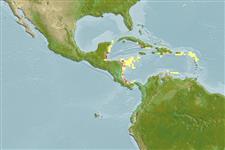>
Gobiiformes (Gobies) >
Gobiidae (Gobies) > Gobiinae
Etymology: Carrigobius: Name from the Latin 'gobius' (goby or gudgeon) and Carrie, referring to Carrie-Bow Cay, Belize, home of the Smithsonian Institution’s field station, where many specimens of Carrigobius amblyrhynchus were collected..
Environment: milieu / climate zone / depth range / distribution range
Sinh thái học
Biển gần đáy; Mức độ sâu 8 - 50 m (Ref. 92840). Tropical
Sự phân bố
Các nước | Các khu vực của FAO | Các hệ sinh thái | Những lần xuất hiện | Point map | Những chỉ dẫn | Faunafri
Western Central Atlantic: Belize.
Bộ gần gũi / Khối lượng (Trọng lượng) / Age
Maturity: Lm ? range ? - ? cm
Max length : 4.0 cm SL con đực/không giới tính; (Ref. 92840)
Short description
Hình thái học | Sinh trắc học
Các tia vây lưng cứng (tổng cộng): 8; Các vây lưng mềm (tổng cộng): 10-11; Tia cứng vây hậu môn 1; Tia mềm vây hậu môn: 8 - 10; Động vật có xương sống: 27. This species is distinguished by having all taxonomic characters present in most members of Gobiosomatini and Gobiosoma group (i.e., first dorsal-fin spines VII, pterygiophore insertion pattern of 3-221110, vertebrae 27, precaudal 11 and caudal 16, hypurals 1 and 2 fused to some extent with hypurals 3 and 4 and the terminal vertebral element, 1 epural); pelvic fins are well separated, lacking both the anterior frenum and well-developed membrane
connecting innermost rays (inter-radial membrane better developed in larvae); pelvic-fin rays
1-5, branched (the fifth ray branched only in mature adults), without fleshy or flattened tips; pelvic-fin rays extending posteriorly to about halfway to the anus or slightly further, but never reaching anus; no scales on the body (modified basicaudal scales absent); two anal-fin pterygiophores are inserted before first haemal spine; no cephalic sensory canals; D2 I,10-11; A I,8-10; body with diffuse dark saddles and a series of evenly spaced midlateral blotches on side of body; anterior profile of head blunt and nearly vertical (Ref. 113825).
Inhabits sandy bottoms in coral-reef habitats (Ref. 92840).
Life cycle and mating behavior
Chín muồi sinh dục | Sự tái sinh sản | Đẻ trứng | Các trứng | Sự sinh sản | Ấu trùng
Tornabene, L., J.L. Van Tassel, D.R. Robertson and C.C. Baldwin, 2016. Molecular phylogeny, analysis of discrete character evolution, and submersible collections facilitate a new classification for a diverse group of gobies (Teleostei: Gobiidae: Gobiosomatini: Nes subgroup), with descriptions of nine new species. Zoological Journal of the Linnean Society 177(4):764-812. (Ref. 113825)
IUCN Red List Status (Ref. 130435)
Threat to humans
Harmless
Human uses
Thêm thông tin
Các nướcCác khu vực của FAOCác hệ sinh tháiNhững lần xuất hiệnNhững chỉ dẫnStocksSinh thái họcThức ănCác loại thức ănThành phần thức ănKhẩu phần
Age/SizeSự sinh trưởngLength-weightLength-lengthLength-frequenciesSinh trắc họcHình thái họcẤu trùngSự biến động ấu trùngBổ xungSự phong phúBRUVS
Các tài liệu tham khảoNuôi trồng thủy sảnTổng quan nuôi trồng thủy sảnCác giốngDi truyềnElectrophoresesDi sảnCác bệnhChế biếnNutrientsMass conversion
Các công cụ
Special reports
Download XML
Các nguồn internet
Estimates based on models
Phylogenetic diversity index (Ref.
82804): PD
50 = 1.0000 [Uniqueness, from 0.5 = low to 2.0 = high].
Bayesian length-weight: a=0.00708 (0.00333 - 0.01504), b=3.09 (2.92 - 3.26), in cm total length, based on LWR estimates for this (Sub)family-body shape (Ref.
93245).
Mức dinh dưỡng (Ref.
69278): 3.2 ±0.3 se; based on size and trophs of closest relatives
Thích nghi nhanh (Ref.
120179): Chiêù cao, thời gian nhân đôi của chủng quần tối thiểu là dưới 15 tháng (Preliminary K or Fecundity.).
Fishing Vulnerability (Ref.
59153): Low vulnerability (10 of 100).
